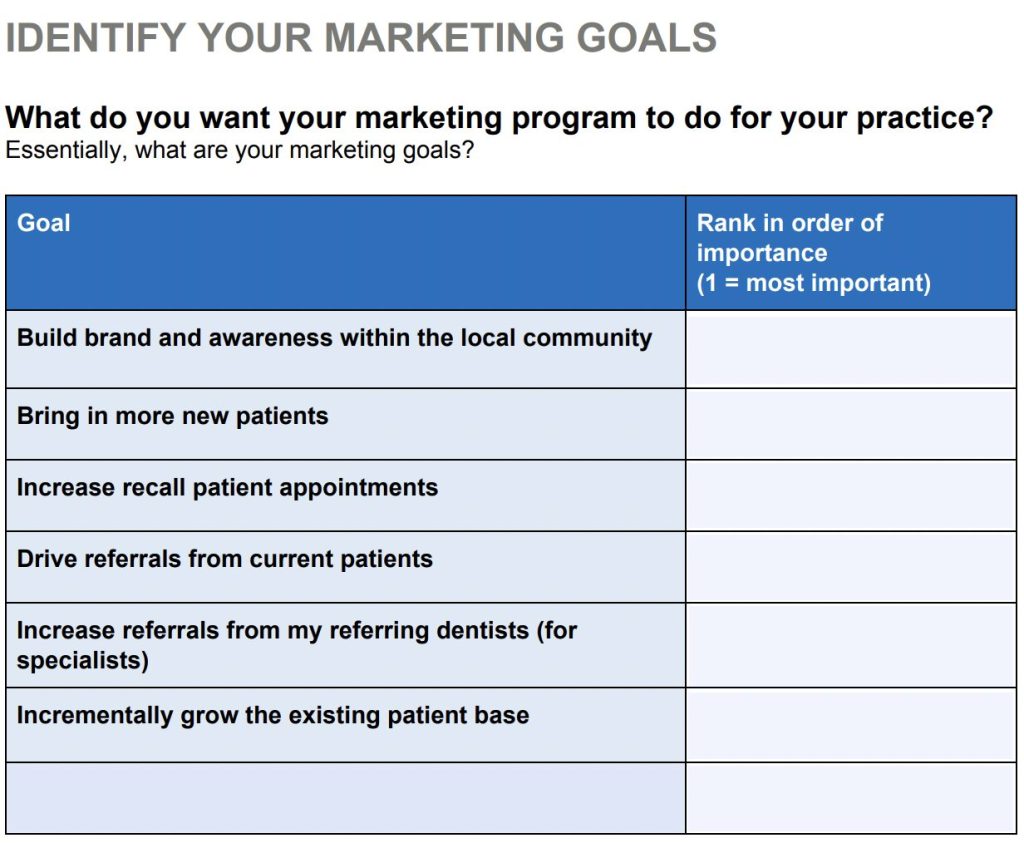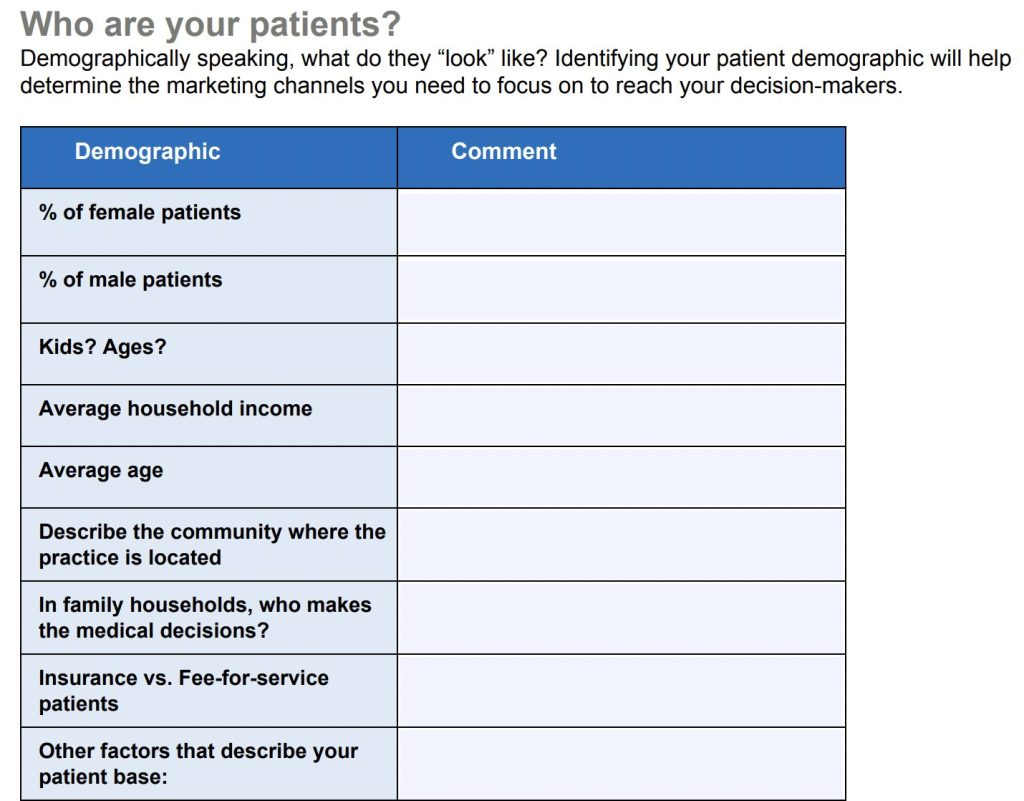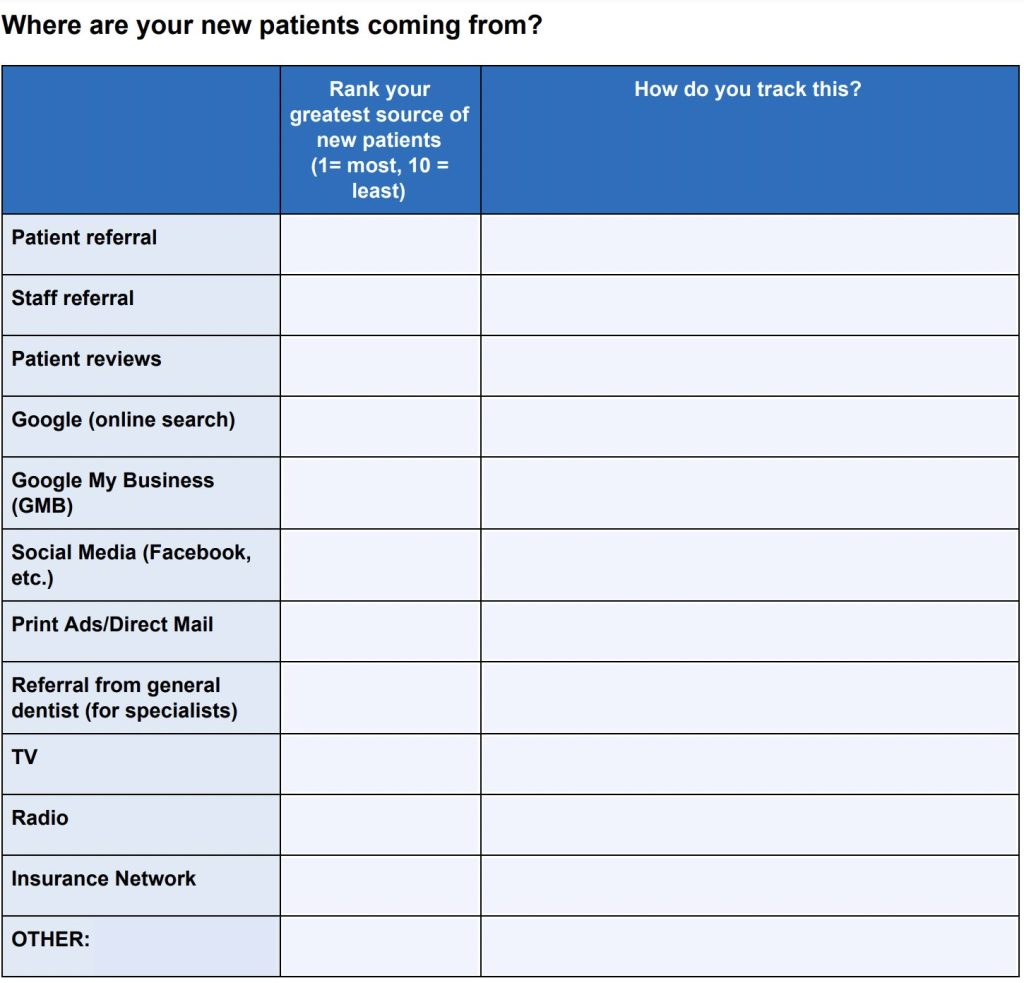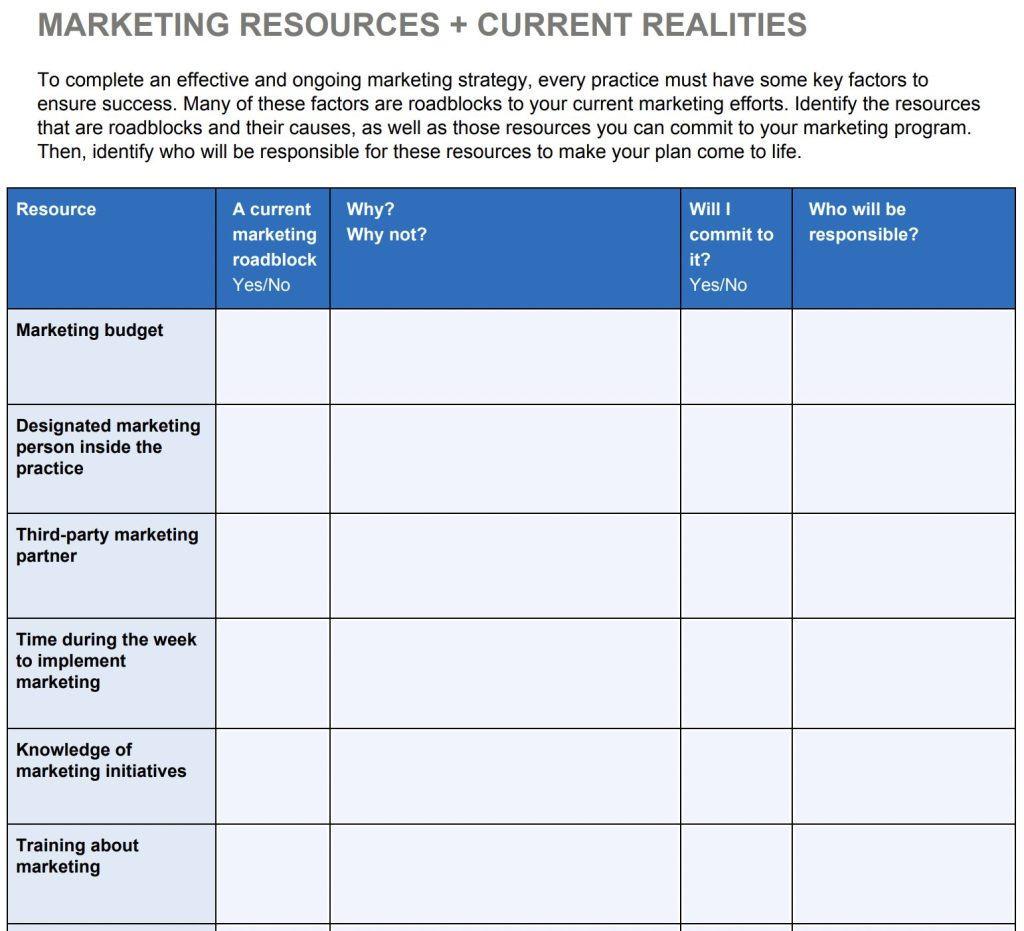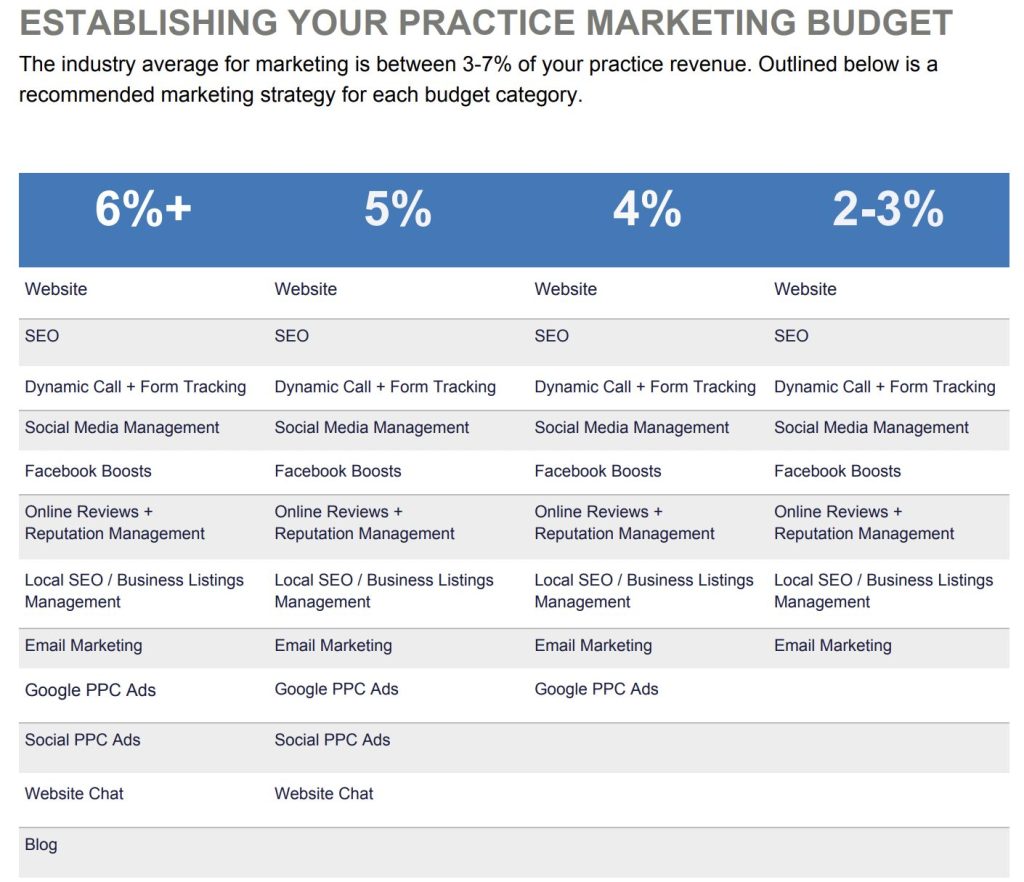With 2022 just around the corner, it’s time to start planning your dental practice marketing strategy for next year. If you’ve never created a marketing action plan for your practice, the thought can be intimidating. However, it often just requires some valuable time spent evaluating current patient data, your goals as a practice and your available resources to accomplish these goals.
To help you through this process, we’ve written this blog based on the marketing workbook we use for each of our clients and their success.
Step 1: Identify Your Practice Marketing Goals
What Are My Marketing Goals?
Before you start creating your plan, think about what your ultimate goal is for your marketing. Consider what you want your marketing plan to do for your practice. Maybe you’d like to bring in more new patients, or build your brand awareness in the local community. Whatever this long-term goal may be, keep it top-of-mind while creating your plan.
Ask yourself these three questions:
- Where do you want to go as a practice?
- Where are you now as a practice?
- How will you get to this end goal?
Step 2: Understand Who Your Patients Are
To succeed in your marketing and accomplish this goal, you need to know your patients and what they’re looking for in a dentist.
- Who are your patients?
- Look at demographics like age, percentage of males to females, average household income and the community where your practice is located.
Step 3: Identify Where Your Patients Are Coming From Currently
- Where are your patients coming from?
- Do they learn about your practice through online reviews, referrals, social media, etc.?
Step 4: Identify the Procedures That Bring Patients To Your Practice
Examine the following data to better understand your average patient profile, and then consider what services they’re using most often:
- What services generate the most revenue for your practice?
- Do you want these services to be your top revenue generator?
- If you want to promote certain services during certain times of year, like back-to-school appointments, make a note during this step.
You’ll also want to list the procedures for which these patients have treatment plans. Identify what procedures bring them to your practice, and what procedures make them stay.
How Does Knowing My Patients Help Me With Marketing?
Evaluating your general patient profile, where your patients are coming from and where your revenue primarily comes from can lead to valuable marketing insights.
For example, if you see your average patient is a female between the ages of 25 and 34 and you’re located in a suburban area, concentrate your social media marketing on Facebook. This is the platform of choice for women within this age range.
Step 5: Identify Your Current Dental Practice Marketing Tactics. What is Working? What Isn’t? How Are You Tracking This?
What Are My Current Marketing Resources?
Now that you have a clear picture of your patients, it’s time to consider our second major question: Where are you now with your marketing plans and resources? What are you currently doing as a practice that you’d like to modify, keep or get rid of entirely? It’s important to audit your existing marketing strategy to understand its strengths, weaknesses and opportunities.
Step 6: Identify Your Current Realities
What Prevents My Marketing Success?
You must be honest with yourself about the current realities of your practice. What roadblocks exist that may prevent you from marketing success? To determine these pain points, consider the following factors:
- Marketing budget
- If you have an internal designated marketing person or third-party marketing partner
- Time available during the week to implement marketing
- Practice knowledge of marketing initiatives
- Practice training about marketing
Step 7: Identify the Marketing Strategies You Will Develop or Implement for 2022 to Attract, Acquire and Retain the Patients You Want
Now that you’ve determined where you are, where you want to go, the profile of your patients, what services they use and how you’ll promote those services, it’s time to decide what marketing initiatives you’ll use to accomplish your end goal:
- Website development, design and maintenance services
- Search engine optimization (SEO)
- Dynamic call and form tracking
- Local SEO/Google My Business
- Patient reviews
- Social media
- Social media boosting and ads
- Google Advertising, commonly known as Google Pay-Per-Click (PPC)
- Blogs
- Email marketing (e-blasts)
- Print collaterals, like brochures and mailers
- Traditional marketing, like TV, radio and print ads
- Patient referral campaigns
- Internal office collateral and graphics
- Community involvement activities and trade shows
Modernizing the Patient Experience
Remember when we evaluated your typical patient? Look at that profile again to determine what modern features they like. For example, if your typical clientele is a younger family with two working parents, they may appreciate features like online scheduling to book appointments for their children after-hours. Other modern features include:
- Website chat
- Online scheduling
- Online patient forms
- Online bill pay
- Online dental insurance checker
Step 8: Identify Your Marketing Budget
As you’re thinking about what marketing initiatives you’d like to include in your 2022 plan, it’s critical to also think about:
- What resources are needed to implement this? (Money, time, team, training, etc.)
- Whose responsibility is it to implement this?
How Much Will Marketing Cost My Practice?
A strong, reliable, efficient marketing plan will require some spending from your practice, so think about how much you’re comfortable spending to accomplish your goals. Will you try to implement your marketing plan by yourself? Do you have staff members you pay to do your marketing for you? Do you have an external marketing partner, like a full-service agency?
The industry standard for dental marketing is three percent to six percent of your practice revenue. The change in cost depends on how much money you want to spend on your Google Pay-Per-Click (PPC) advertising and your social media pay-per-click advertising.
Step 9: Determine How You Will Track and Analyze the Effectiveness of Your Marketing Plan
Is My Marketing Plan Successful?
As you roll out your marketing plan, it is just as important to track its success and make necessary adjustments and improvements as it was to initially create the strategy. Make sure you are carefully analyzing the return on investment of each marketing initiative you use.
How to Track Your Marketing Success
Here are common ways to track your marketing success:
- Dynamic call and form tracking
- Phone call recording and listening
- Google Analytics
- Google My Business insights
- Social media insights
- Questions on patient forms, i.e. “How did you hear about our practice?”
- Your staff directly asking patients how they learned about your practice
Step 10: Commit to Your Marketing Strategy and Get Started
Now that you’ve closely evaluated the marketing needs, current realities, patient profile and tracking methods for your practice, it’s time to get started. Kick off your planning for your 2022 marketing and begin crafting your marketing action plan today.
Here to Help With Your Dental Marketing Needs
At Whiteboard Marketing, we specialize in helping you attract, acquire and retain the patients you want. For more information and hands-on, in-depth marketing activities, download our Practice Marketing Plan Workbook.
Written by Anna L. Davies, Digital Marketing Specialist at Whiteboard Marketing.


